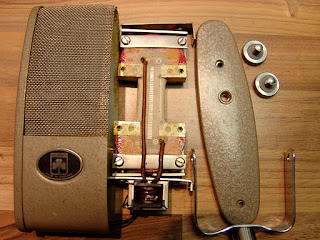November’s microphone of the month is a British long-format ribbon that was sold under the names “Lustraphone” and ‘Grundig”.
 |
| A Lustraphone-badged ribbon microphone in glorious brushed stainless steel finish |
This mic was available in at least three different impedances, and I have come across 30, 200, and high impedance models. Unfortunately the badge often falls off so you don’t always know what you are getting! Most of the models I have seen are finished in a bronze hammerite colour, although there is a deluxe low impedance model which has a gorgeous brushed stainless steel finish. Despite the different badges and finishes, the mics are exactly the same on the inside (transformer aside).
 |
| Lustraphone ribbon microphones on the bench |
One of the ribbon clamps sits on a spring-tensioned screw thread, which allows fine adjustment of the ribbon tension. This makes tuning the ribbon very straight-forward, and allows the owner a little bit of grace if the ribbon becomes a little stretched over time. This feature should probably be mandatory on all ribbonmics!
 |
| Grundig badged lustraphone mic, opened up for service |
The magnetic field is supplied by a pair of horseshoe magnets (which unfortunately sometimes age with time, losing their strength). Connection to the rest of the world is made by a balanced three-pin paxolin plug, which are hard to come by now. The middle pin is ground, with the audio on the outer two pins.
 |
| Rear connector and original plug. |
Fortunately, a male XLR connector can be modified to fit by slicing off part of the barrel.
 |
| XLR connector modified to fit the mic. |
The long ribbon and motor design gives these mics a full bottom end and a pronounced proximity effect. Here are the frequency plots for three of these mics that we have serviced recently:
 |
| Lustraphone ribbon mic frequency plots. |
(Thanks to Mark Stevens for additional information).
Update 23/1/12. These microphones were also sold under the brand Pamphonic. One appeared recently on ebay:


